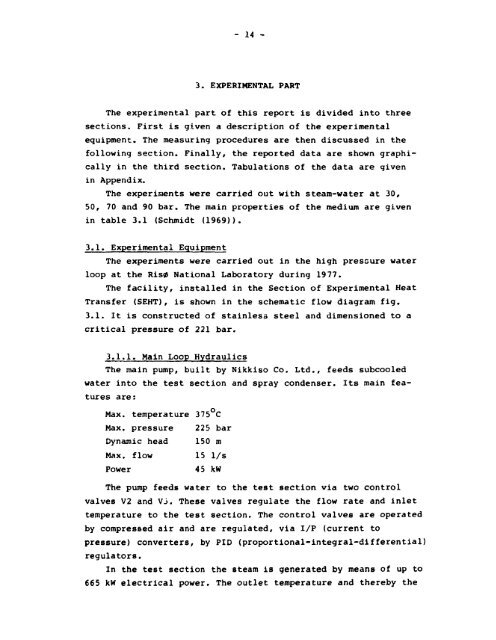An Experimental and Theoretical £ Investigation of Annular Steam ...
An Experimental and Theoretical £ Investigation of Annular Steam ...
An Experimental and Theoretical £ Investigation of Annular Steam ...
Create successful ePaper yourself
Turn your PDF publications into a flip-book with our unique Google optimized e-Paper software.
- 14 -<br />
3. EXPERIMENTAL PART<br />
The experimental part <strong>of</strong> this report is divided into three<br />
sections. First is given a description <strong>of</strong> the experimental<br />
equipment. The measuring procedures are then discussed in the<br />
following section. Finally, the reported data are shown graphically<br />
in the third section. Tabulations <strong>of</strong> the data are given<br />
in Appendix.<br />
The experiments were carried out with steam-water at 30,<br />
50, 70 <strong>and</strong> 90 bar. The main properties <strong>of</strong> the medium are given<br />
in table 3.1 (Schmidt (1969)).<br />
3.1. <strong>Experimental</strong> Equipment<br />
The experiments were carried out in the high pressure water<br />
loop at the Risø National Laboratory during 1977.<br />
The facility, installed in the Section <strong>of</strong> <strong>Experimental</strong> Heat<br />
Transfer (SEHT), is shown in the schematic flow diagram fig.<br />
3.1. It is constructed <strong>of</strong> stainless steel <strong>and</strong> dimensioned to a<br />
critical pressure <strong>of</strong> 221 bar.<br />
3.1.1. Main Loop Hydraulics<br />
The main pump, built by Nikkiso Co. Ltd., feeds subcooled<br />
water into the test section <strong>and</strong> spray condenser. Its main features<br />
are:<br />
Max. temperature 375 C<br />
Max. pressure<br />
Dynamic head<br />
225 bar<br />
150 m<br />
Max. flow 15 1/s<br />
Power<br />
45 kW<br />
The pump feeds water to the test section via two control<br />
valves V2 <strong>and</strong> Vj. These valves regulate the flow rate <strong>and</strong> inlet<br />
temperature to the test section. The control valves are operated<br />
by compressed air <strong>and</strong> are regulated, via I/P (current to<br />
pressure) converters, by PID (proportional-integral-differential)<br />
regulators.<br />
In the test section the steam is generated by means <strong>of</strong> up to<br />
665 kW electrical power. The outlet temperature <strong>and</strong> thereby the
















